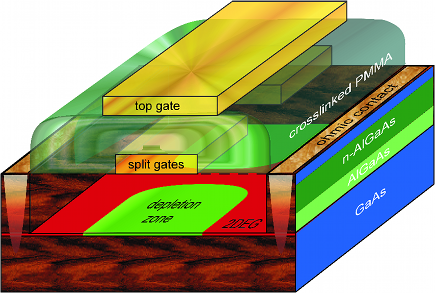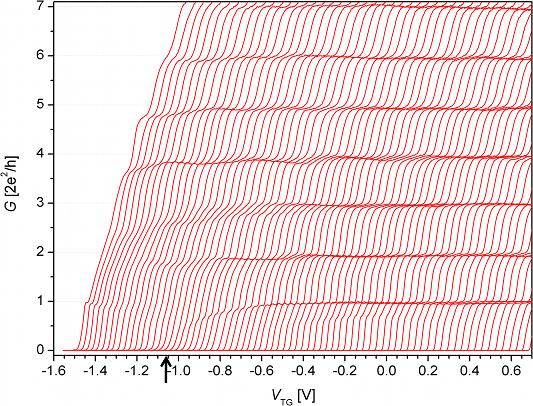Incipient formation of an electron lattice in weakly confined quantum wires
In an electron system with a sufficiently low density that the electrons can be considered as point-like classical charges, Coulomb repulsion becomes the dominant interaction. In such a system electrons minimize their Coulomb repulsion by positioning themselves at equidistant sites along a line, i.e. a 1D Wigner crystal. It is predicted that when the Coulomb repulsion becomes sufficiently strong to overcome the electrostatic potential which confines the electrons, they adjust their positions to minimize their energy, initially forming a zigzag lattice. This can be achieved by either increasing the electron density, or weakening the confinement. As the confinement weakens further it is predicted that the electrons will divide initially into two and then more rows.
 Figure 1: Top-gated split-gate device.
Figure 1: Top-gated split-gate device.We have explored the behaviour of weakly confined, low density quantum wires at low temperatures, using a combination of split gates and a top gate fabricated on GaAs/AlGaAs heterostructures. These devices allow independent control over the carrier density and confinement potential. Figure 2 shows conductance characteristics of the device, as the top-gate voltage (VTG) is swept for a fixed split-gate voltage (VSG). From left to right, VSG is stepped negatively, thus increasing the confinement strength. When the wire is strongly confined (right), the standard ballistic quantization of conductance is observed with plateaux at multiples of 2e2/h. At intermediate confinement we observe a jump in conductance to 4e2/h (marked by the arrow), indicative of two rows conducting in parallel. The characteristics of this 'double-row regime' have been extensively investigated using various measurement techniques, including magnetic field and dc-bias dependence.
 Figure 2: Conductance characteristics of the device as a double row of electrons forms (marked by the arrow).
Figure 2: Conductance characteristics of the device as a double row of electrons forms (marked by the arrow).Similar experiments were performed on split-gate devices with a wider geometry, which showed a coupling of energy levels in the double-row regime, giving rise to hybridized bonding and antibonding states. We further investigated the interplay between confinement strength and carrier density by fabricating devices with an additional back gate to vary the overall 2D carrier density. Using these devices we were able to tune in and out of the double-row regime as a function of density.
The flexibility of our devices has allowed the exploration of this weak confinement regime, and has opened the door to the observation of previously inaccessible transport phenomena. The formation of a double row is the first step towards a more complex lattice of increased numbers of rows.
These results are reported in:
- W. K. Hew et al., "Tuning the confinement strength in a split-gate quantum wire", Physica E 40, 1645 (2008).
- W. K. Hew et al., "Incipient formation of an electron lattice in a weakly confined quantum wire", Phys. Rev. Lett. 102, 056804 (2009).
- L. W. Smith et al., "Row coupling in an interacting quasi-one-dimensional quantum wire investigated using transport measurements", Phys. Rev. B 80, 041306 (2009).
- L. W. Smith et al., "Coupled double-row formation in a quasi-1D wire", Physica E 42, 1114 (2010).
For further information please contact: Luke Smith.
